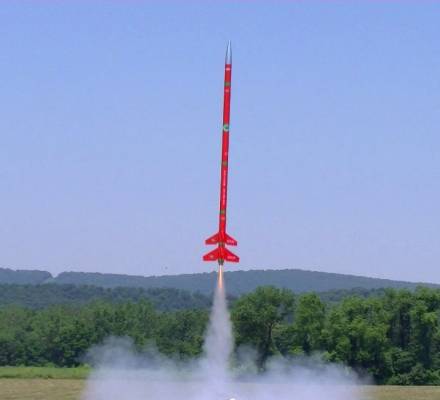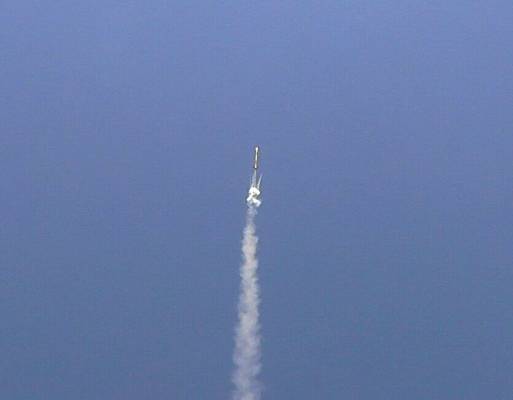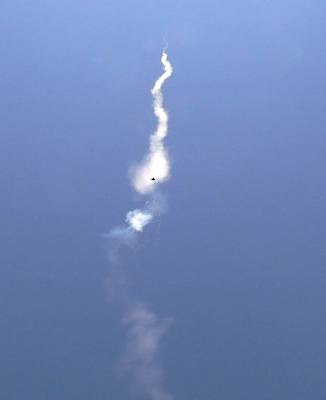The Comanche 3: Estes 3-stage Comanche 3 is a 'stratosphere chaser'. It is designed to go very high. Because of that feature, bright orange paint is suggested and it uses dual streamers instead of a parachute to make it less likely to drift away unseen. The upper and mid stages use standard 18mm motors. The lowest stage uses a 24mm motor. This rocket can fly with any combination of stages, one, two or three. (Obviously you need the top stage if you want it to fly and recover properly.)
HISTORY AND MODS:
I got this kit as a package deal on eBay, it was extra cheap, but it had some damage. The main body tube suffered a minor crush, and the 1st stage tube did also. As a result, I had to cut this to be a little shorter than stock, but I was able to take the top few inches of the tube and with a coupler I could use it as a payload bay since I like payloaders anyway. As luck would have, the crush damage to the 1st stage body tube was minor and all under the stage coupler, so the added strength of the coupler made it useable as is.
I made a few minor mods to the kit. As already mentioned, the main body tube is a few inches shorter than stock. I glued in an ejection baffle and tied a Kevlar shock cord mount to this. The Kevlar length was just short of the end of the tube to prevent zipper damage. On the payload tube section I added static vent ports for an altimeter. I glued the fins a bit more forward than the instructions stated, to make it easier to insert/remove the friction-fit engines.
The Comanche 3 is the second rocket where I paper-covered the balsa fins so I don't have the drudgery of sealing-sanding-sealing-sanding...... I hope this can make the fins a bit more rigid or stronger, but it's hard to tell. I didn't bother to putty-fill the fin fillets, figuring that a) I don't care about drag reduction as this thing will sail out of sight anyway, and b) if what I read on this site is true, I'll be re-gluing the fins on a regular basis, and they'll end up looking pretty ugly anyway.
I intend to try to fly this with an under-sized parachute instead of the streamers. I find it easier to pack a quality Nylon 'chute than roll a couple of streamers up, and by varying the diameter, I can get a more controlled descent speed (Aiming for about 15mph.) I flew it with a 12" chute but it came down too slow, so I changed it out for a 9" chute for the next test flight, which also saved 5 grams of weight. I always fly in a large field and the rocket always lands in grass, so I don't expect broken fins.
I also tapered the cuts on the launch lugs, and added 1/8" lugs in case I want to fly it as a single stage. (The kit is supplied with larger 3/16" lugs and therefore requires a larger launch rod.) Because of the dimensional changes, I also had to change the exact location of the decals (not that the instructions were very clear about where they go in the first place!)
On many of my rockets, I placed a small mark between body tube sections so I can quickly orient them when assembling the rocket (nosecone-payload-body tube-stages). For some reason I didn't want to do that with this model, so I glued a small balsa strip that runs from the top of the 3rd stage to the base of the 1st stage when the stages were aligned as I wished. I then cut the strip at the joints, so I have a physical identifier that tells me the stages are all aligned correctly (including the alignment of all three fin sets.) It's a nice little detail that looks "technical", and will positively ID my stages if I ever drag-race another Comanche 3.
STAGING:
The last modification that I did, I apparently did without knowing it. Somehow, the 3rd stage 24mm engine sits aft about 3/16" too far, so it is not closely coupled to the 2nd stage nozzle. As a result, I might have reliability problems igniting the 2nd stage, and if it does ignite, an internal section of the 3rd stage body tube will be exposed to pressurized exhaust gasses for a bit and will probably burn through and fail after a few flights. I re-checked all the dimensions of the rocket and reviewed the instructions again, but it all adds up OK. Did Estes make a mistake here?
The 3rd stage tube is exactly 70mm to fit a C11 or D12 motor, but the motor is forced back by 1/2 inch because of the 1" stage coupler which is inserted and glued exactly 1/2" into the tube. The protruding motor is fine because it allows us to remove the empty casing. The 1st and 2nd stages are supposed to be offset by this same 1/2 inch aft, so they mate closely with the lower stages. I verified the 1/2 inch offset of the 3rd stage coupler, and also verified the 1/4" overhang of the motor in the upper stage and they are exactly as the instructions state. This 1/4" overhang pushes the mid-stage engine out by that same 1/4". So what's wrong? Should the mid-stage overhang by 1/2 inch instead of 1/4"?
Either way the solution is simple. The upper stage and the mid stage will work fine as is, but if I want to use the lowest 24mm booster stage - with or without the mid-stage, I need to add a 3/16" spacer (cut from a used engine casing) to the engine block of the upper stage to keep the motor out a little further, making it a close couple to the lowest stage. I still haven't figured out this mystery.
TEST FLIGHTS: So far I flew it once as a single stage on a B6-4. It reached 233 feet and 78mph. Ejection was a bit late but acceptable. It recovered at only 8mph descent, about twice as slow as I would have liked. It was not affected much by the somewhat stiff winds. This rocket has flown higher than the Cape Hatteras Lighthouse in NC, the tallest lighthouse in the USA.
With a C6-5 it flew to 668 feet, higher than the Gateway Arch in St. Louis, the Singer Building in NY, and the Washington Monument in DC. Ejection was near perfectly timed. A smaller parachute made it descend a bit faster, but only at 10mph. Hopefully a little nose-weight balanced against the 3 motors will help it fall a bit faster and reduce the odds of it getting lost.
| Flight Date: | 2012-06-10 |
| Rocket Name: | Comanche 3 |
| Kit Name: | Estes - Comanche-3 {Kit} (1382) [1982-2012] |
| Flyer's Name: | Rich DeAngelis |
| Motors: | B6-0/B6-6 |
| Launch Site: | Halifax, PA |
| Actual Altitude: | 628 Feet |
I loaded the Comanche 3 up for a third 2-stage test flight. Experimenting with low-power multi-staging flights again, I wanted to try a larger sustainer this time to compare the A8 vs. the B6 for a second stage. I decided to again use the B6 booster to keep altitudes under control and photograph the staging at a lower altitude.
Scott pressed the button and lit the booster. Ignition and staging went well, and although the specified burn times for the B6 motors is 0.86 seconds each, the Altimeter Two only recorded a 8/10 second burn time overall. Video confirms it was much longer. I do not understand how or why, the rest of the data seemed correct. Again this flight recorded even higher acceleration values, with a peak of 18.9 Gs and an average of 7.4 Gs, both very strong numbers. The rocket reached a record high velocity of 134 mph, although only besting a single C6 motor by 1 mph. Since two B6’s have about the same propellant as a single C6, this data does not show the 2-stage method as doing any better than a single stage, I suppose because the 2-stage has 2X the weight of the motor casing and engine nozzle as well as more fins. I expect a pair of C6’s would be phenomenal.
Whatever the numbers say, the flight went well and the flight path was straight vertical. In spite of the rocket using a 6 second delay sustainer motor, it fired early after only 4.8 seconds. This was the Comanche 3’s fourth-consecutive flight with a delay time less than ideal, which continues to limit this rocket’s altitude potential.
With the parachute deploying it traveled an additional 20 feet up in 7/10 seconds to a peak apogee of 628 feet. This also was not quite as good as a single C6 motor. This shows me that the B6-0 booster, although powerful, again does not sustain long enough to take advantage of its own liftoff strength. The C6 is definitely a more efficient low-power booster.
With a good chute, it descended to a grass landing at 14 mph. It landed only about 25 feet from the launch pad, and the booster literally landed at the base of the launch rod. Again, this was more good data, but not the motor combination I will use often. After three consecutive and successful 2-stage flights, it was time to give this rocket a rest for the day. Future flights will explore the use of both C6-0 and 24mm D12 booster motors.
| Stage | Motor(s) |
|---|---|
| 1 | Estes B6-0 |
| 2 | Estes B6-6 |
 |
 |


